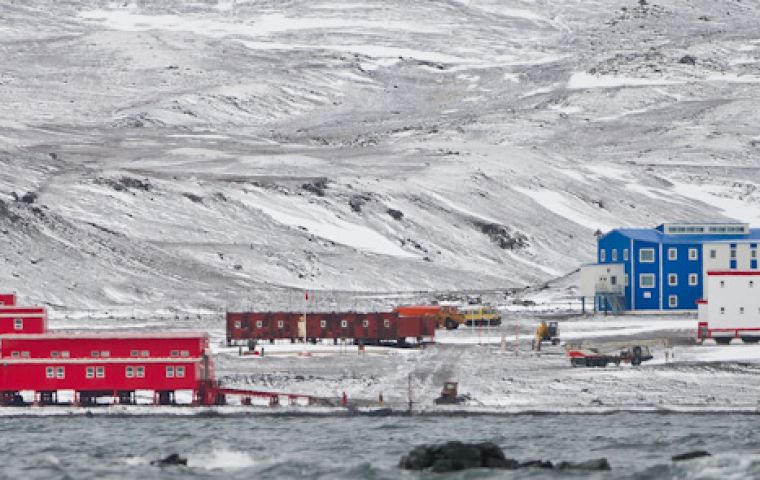MercoPress. South Atlantic News Agency
China celebrates 30 years of first research station in Antarctica
 The Great Wall on King George Island was the first Chinese scientific station in Antarctica opened in 1985 (Pic M. Foote)
The Great Wall on King George Island was the first Chinese scientific station in Antarctica opened in 1985 (Pic M. Foote)  The scientists recalled that three decades ago it was late Chinese leader Deng Xiaoping who sent the first team to Antarctica.
The scientists recalled that three decades ago it was late Chinese leader Deng Xiaoping who sent the first team to Antarctica.  China's 31st Antarctic expedition, consisting of 281 team members, is perhaps one of the largest operations currently on the continent.
China's 31st Antarctic expedition, consisting of 281 team members, is perhaps one of the largest operations currently on the continent. China is preparing to mark 30 years of polar expeditions, when on 20 February 1985 opened its first permanent research station in Antarctica, The Great Wall on King George Island. Since then China has continued to advance and is now planning the fifth permanent station.
Compared with West countries that first landed in Antarctica in 1820, the Chinese are relatively newcomers, arriving 75 years later than Japan, the first Asian country to record an expedition to the “end of the world” in 1910.
However, according to Joan N. Boothe, from Stanford University and author of “The Storied Ice”, it is possible that a Chinese fleet arrived in the area around 1421 or 1422, first visiting the Falkland Islands, before sailing south to the Antarctic Peninsula.
China's 31st Antarctic expedition, consisting of 281 team members, is perhaps one of the largest operations currently on the continent.
The team has a full agenda, including building a base for the Beidou navigation satellite system, selecting a site for an airstrip for fixed-wing aircraft on the ice sheet, installing a new astronomical telescope and surveying more areas to map them.
As a gift for the 30th anniversary, a rare greenhouse was built by the team, where 20 varieties of vegetable were planted. The team has also completed a survey of a site for the country's fifth Antarctic station.
“We were inspired by the instructions of President Xi Jinping” said team vice leader Wang Hailang. Xi boarded the icebreaker Xuelong (Snow Dragon) at Hobart during his Australian visit in November last year, becoming the first Chinese leader to board a polar research ship, speak with the crew and wished them luck with their mission.
The scientists recalled that three decades ago it was late Chinese leader Deng Xiaoping who sent the first team to Antarctica.
Jin Tao, a science writer and member of the first expedition, said that China could not play a part in polar matter unless it established a station on the continent. Shortly after China founded the Great Wall Station, it gained the consultative status under the Antarctic Treaty, meaning it gained the right to vote in Antarctic affairs.
Guo Kun, China's first polar station chief, said that his team were overwhelmed when the Chinese national flag was erected on King George Island on 30 December 1984.
Their work was aided by a number of countries, including Australia, New Zealand, Peru, Chile, Argentina, Uruguay, Japan and the former Soviet Union, according to Guo.
Since then, China has established four stations in Antarctica -- the Great Wall in 1985, Zhongshan in 1989, Kunlun in 2009 and Taishan in 2014. The fifth will be constructed later this year in the Victoria Land east of the continent.
Besides doing scientific research 359 geological sites had Chinese names by 2011. Among the total 37,000 named places in Antarctica, the United States has named 13,000 in English.
Chinese elements have livened up the white continent with exotic colors. During the construction of the Kunlun station in Dome-A, 1,200 kilometers away from the coast, a Buddha statue and a traditional Chinese bronze sacrificial vessel were brought to the highland to bestow good luck.
Many ordinary Chinese are fascinated with the continent. Data collected from local travel agencies in South America showed that more than 2,000 Chinese go to Antarctica annually.
As the number of visitors’ increases, Western tourist agencies have opened offices in China to meet the emerging demands. Xu Qi, head of Norway's Hurtigruten Beijing Bureau, said that the company had arranged several charted ships to cater to the nouveau riches, who flock polar cruising trips.




Top Comments
Disclaimer & comment rules-

-

-

Read all commentsCHINA=Argentina =best mates lolol
Feb 19th, 2015 - 12:25 am 0still,
you wont hear CFK complaining that China is militarising the south Atlantic and thus Argentine territory,
seeing as they will soon both be one nation...lol
The island was discovered and named by the British explorer William Smith in 1819.
Feb 19th, 2015 - 01:47 am 0King George Island is the largest of the South Shetland Islands, lying 120 kilometres (75 miles) off the coast of Antarctica in the Southern Ocean. The island was named after King George III.
just so you know, like...
:-)
Surprised they haven't named one of their bases Tiananmen Square.
Feb 19th, 2015 - 08:58 am 0Where all of us not hidden behind the great firewall of China, know in 1989 they murdered hundreds of peaceful protestors.
http://en.wikipedia.org/wiki/Tiananmen_Square_protests_of_1989
So a country quite similar to Argentina.
Commenting for this story is now closed.
If you have a Facebook account, become a fan and comment on our Facebook Page!